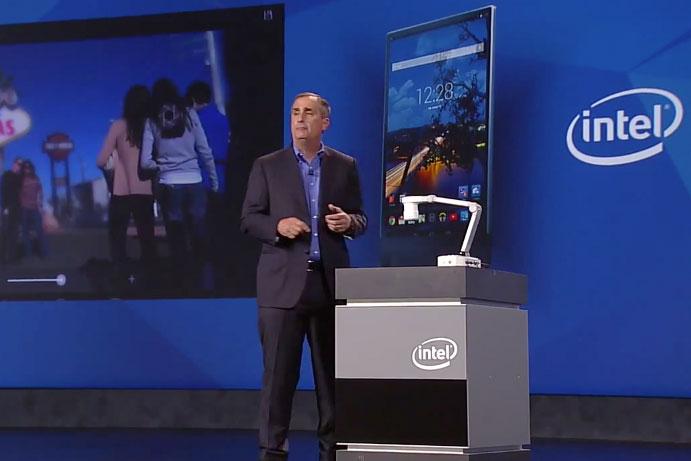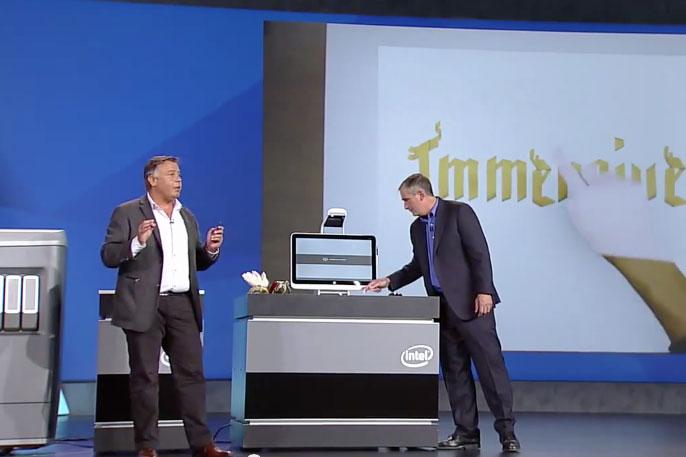Another year, another CES, another Intel keynote. The company’s event is arguably the most important conference of the entire show, and it’s certainly among the most heavily attended. What Intel does or does not say indicates the direction for thousands of smaller companies that depend on its technology.
Intel had a number of demos to show off, but the company’s focus felt broader than usual. This was due in no small part to the lack of a technically focused press conference, which traditionally happens the day before the keynote and highlights Intel’s core processor business. 2015’s scattershot approach risks turning the company into a jack-of-all-trades, but it may be just what it needs to get ahead of tomorrow’s trends.
The 3D World
The only portion of Intel’s keynote that focused on computers was arguably its weakest. It’s odd given that CES 2015 was the launch of its mainstream fifth-generation Core mobile chips, but very little was said about them. Instead, CEO Brian Krzanich let RealSense hog the spotlight.
RealSense, a 3D camera capable of recognizing gestures, scanning 3D objects, and much more, was originally shown at CES 2014. It was a bit of a flop, which is likely why it didn’t reach retail in mid-2014 as intended. A year of work has provided the opportunity for polish but it’s still not clear why a typical home user would want the camera in a computer. There are niche cases, like the cooking scenario illustrated on stage, but in daily use RealSense still feels obtuse.
There was one compelling demo: HP’s Sprout and multi-jet fusion 3D printer. Both could provide legitimate use for 3D sensors, but they’ve been previously announced and aren’t built for home users. When it comes to PCs, then, the keynote felt like an intentional whiff.
Using RealSense where it makes sense
After a brief review of RealSense in computers, Krzanich rolled into an unexpected domain: Robots. A remotely controlled conferencing device from iRobot rolled on to stage, giving the company’s CEO Colin Angle a chance to speak to Krzanich from his home office. The somewhat awkward exchange didn’t do much to enhance telepresence as a legitimate form of communication, but it did prove that Intel’s 3D camera and processor technology has applications beyond computing.

What really blew the lid off the conference, though, was a demo of automated drones with RealSense technology. A trio of demonstrators joined Krzanich to show how the mildly self-aware drones can automatically avoid people and objects before throwing one of the drones into an obstacle course. The demo packed a punch because it was quick, dynamic, and worked perfectly, unlike the earlier demos of RealSense facial and gesture technology that sometimes needed a few moments to work.
On a more touching note, an employee of Intel named Darryl Adams was welcomed on stage to demonstrate how RealSense can help people overcome their disabilities. Adams, who lives with a degenerative eye disease, struggles with limited range of vision that makes it difficult to keep tabs on his surroundings.

To help him, Intel developed a vest with a RealSense camera than translates nearby movement into touch sensations through vibrating pads. It wasn’t a demo that translated well to the stage, unfortunately, but it’s nice to see a less frivolous use of the technology.
The wearable award bares fruit
Intel wrapped up its demos with some talk about Quark, the company’s tiny, super-low-power x86 system-on-a-chip for wearable devices. Quark is a small product, but it’s a big deal for the company. Intel completely missed the boat on mobile hardware, a fact it admitted to by almost completely ignoring tablets and smartphones during its keynote. The giant must move more quickly to get ahead of up-and-coming trends.

Whether its efforts in wearables will ultimately be competitive with the ARM alternatives is impossible to say, but Krzanich was at least able to demonstrate the results of the wearable challenge Intel issued last year. He invited the founders of Nixie on stage to show their wearable camera drone that can be thrown from the users wrist to take a particularly complicated selfie. It worked perfectly on the first try, flying from the user and making a loop within a matter of seconds.
While obviously a rough product in early stages of development, its potential is immediately obvious, and its existence offers hope that Intel won’t be caught off-guard as it was by mobile five years ago.
Everything and the kitchen sink
Packing so much into a single presentation usually isn’t a good idea, but Intel made it work this year. RealSense was the not entirely obvious connecting thread stringing most of the demonstrations together. Its presence was subtle enough that it would have been missed if not for Krzanich’s constant reminders.

That would normally be a weakness, but let’s face it: This is Intel. Everyone knows the company and what it’s doing, and everybody wants to work with it. The struggle is not publicity, clarity, or recognition, but instead the never-ending challenge of guiding the world’s largest processor manufacturer through the constantly shifting terrain of consumer technology.
In that regard the keynote was a success, tying several up-and-coming fields neatly into one package. Whether the demonstrations translate to widely used products is impossible to say, but Intel is catching wearables, robots, and drones much earlier in their evolution than it did mobile – and that gives it a fighting chance.




